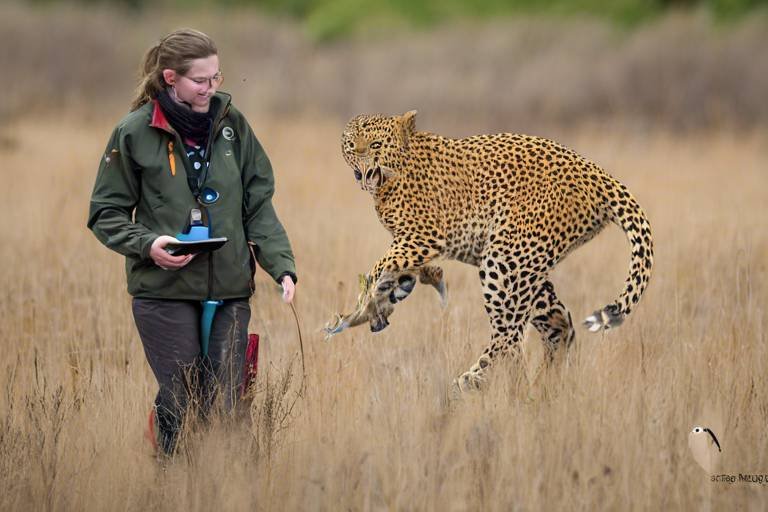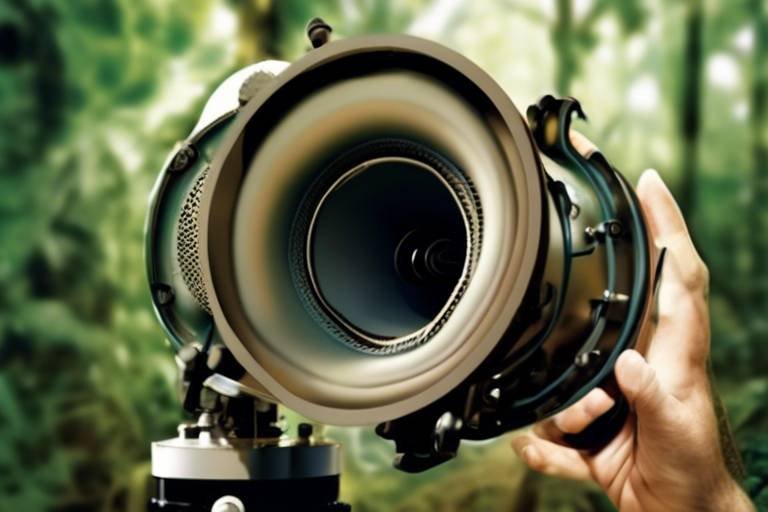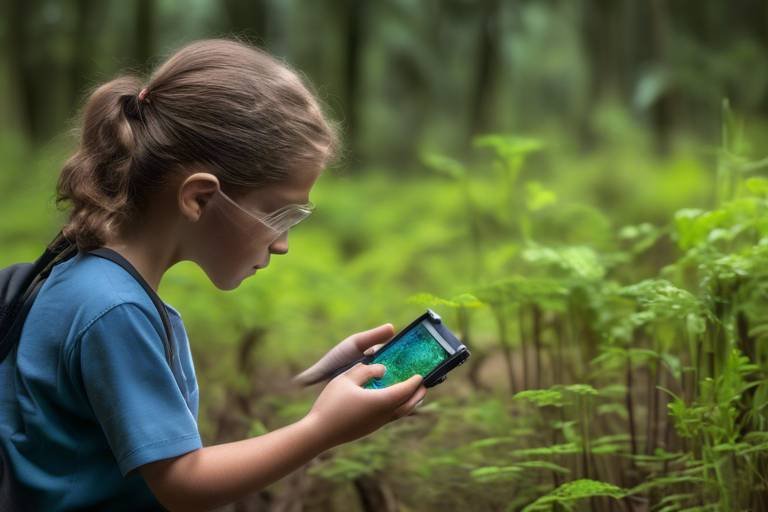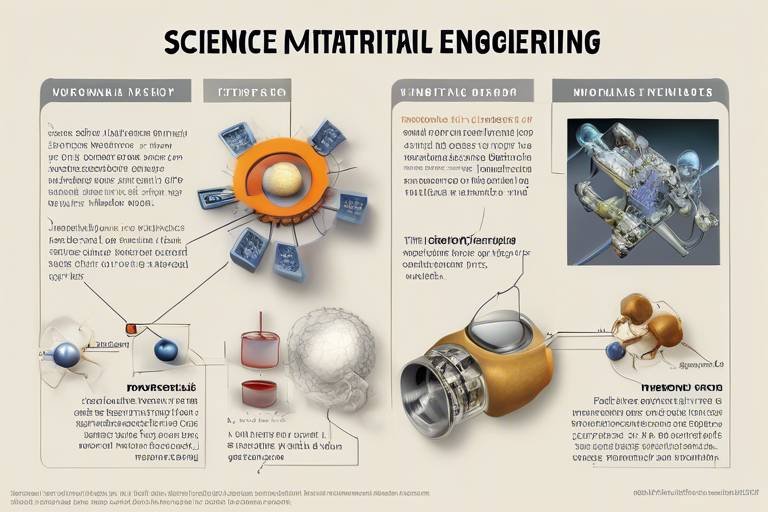Exploring the Role of Technology in Wildlife Tracking
In today's world, technology is revolutionizing the way we understand and interact with the natural environment. When it comes to wildlife tracking, the integration of modern technology is not just a trend; it's a game-changer. Imagine being able to follow the journey of a majestic elephant as it roams across vast savannas or tracking the migration of a flock of birds with pinpoint accuracy. This is no longer a distant dream but a reality thanks to advancements in technology. The ability to monitor wildlife has profound implications for conservation efforts, data collection, and our overall understanding of animal behavior and habitats.
The use of technology in wildlife tracking enhances our ability to gather data that was previously unimaginable. With tools like GPS and satellite tracking, researchers can now collect real-time information about animal movements, which is crucial for developing effective conservation strategies. For instance, when a species is endangered, having immediate access to location data allows conservationists to take swift action to protect these animals and their habitats. This not only helps in preserving biodiversity but also ensures that ecosystems remain balanced.
Furthermore, technology fosters a deeper connection between humans and wildlife. As we learn more about the habits and habitats of various species, we cultivate a sense of responsibility towards their conservation. This relationship is especially important in an era where human activities increasingly threaten wildlife through habitat destruction, climate change, and poaching. By utilizing technology, we can bridge the gap between humans and nature, promoting a more harmonious coexistence.
The future of wildlife tracking is bright, with innovations on the horizon that promise to further enhance our understanding of the animal kingdom. We are only beginning to scratch the surface of what technology can achieve in this field. As we explore the role of technology in wildlife tracking, it becomes clear that the benefits extend far beyond mere observation; they are integral to the survival of countless species and the health of our planet.
From traditional methods to advanced GPS and satellite technology, this section explores the historical progression and innovations that have shaped wildlife tracking practices over the years.
GPS technology offers significant advantages for wildlife tracking, including real-time location data, improved accuracy, and the ability to monitor animal movements over vast distances.
Real-time data collection allows researchers to monitor animal behavior instantly, leading to timely interventions and more effective conservation strategies in response to environmental changes.
With real-time tracking, researchers can gather extensive data on migration patterns, social interactions, and habitat use, significantly enhancing the understanding of wildlife ecology.
Real-time data enables conservationists to implement immediate actions to protect endangered species and their habitats, making wildlife management more proactive and effective.
Despite its benefits, GPS tracking presents challenges, including high costs, battery limitations, and potential impacts on animal behavior, necessitating careful consideration in research design.
In addition to GPS, various alternative technologies such as RFID, camera traps, and drones are emerging, each offering unique advantages for wildlife tracking and monitoring.
Camera traps provide a non-invasive method for monitoring wildlife, capturing images and videos that help researchers study animal behavior and population dynamics without direct human interference.
Drones are increasingly used in wildlife research for aerial surveys and habitat monitoring, providing valuable insights into animal populations and environmental changes from a unique perspective.
As technology continues to advance, the future of wildlife tracking holds exciting possibilities, including the integration of artificial intelligence and machine learning for enhanced data analysis and predictive modeling.
- What is wildlife tracking? Wildlife tracking involves monitoring the movements and behaviors of animals using various technologies to gather data for research and conservation.
- How does GPS tracking work? GPS tracking uses satellites to determine the precise location of an animal equipped with a GPS collar or tag, allowing researchers to monitor its movements in real-time.
- What are the benefits of technology in wildlife conservation? Technology enhances data accuracy, enables real-time monitoring, and allows for immediate conservation action, ultimately improving the chances of species survival.
- What challenges do researchers face with wildlife tracking? Challenges include high costs of technology, battery life limitations for tracking devices, and the potential impact of tracking devices on animal behavior.
The Evolution of Wildlife Tracking Technology
Wildlife tracking has come a long way since the days when researchers relied on basic observational techniques and rudimentary tools. Initially, tracking involved simple methods such as footprint analysis and the use of binoculars to spot animals from a distance. These traditional methods, while valuable, had significant limitations in terms of accuracy and the scope of data collected. However, as technology advanced, so too did the methods for tracking wildlife, leading to a revolution in conservation efforts.
The introduction of radio telemetry in the mid-20th century marked a significant turning point. Researchers began using radio collars to track the movements of animals over larger areas, allowing for more precise data collection. This innovation paved the way for the use of GPS technology, which emerged in the late 20th century. With GPS, researchers gained access to real-time location data, enabling them to monitor animal movements with unprecedented accuracy.
Today, wildlife tracking technology encompasses a variety of sophisticated tools and methods. For instance, satellite tracking has become increasingly popular, allowing scientists to track animals across continents. This technology not only provides location data but also offers insights into migration patterns and habitat use. The evolution of wildlife tracking technology can be summarized in the following table:
| Tracking Method | Description | Advantages |
|---|---|---|
| Traditional Methods | Observation and footprint analysis | Low cost, no equipment required |
| Radio Telemetry | Use of radio collars to track movements | Increased accuracy, larger tracking range |
| GPS Technology | Global Positioning System for real-time tracking | High precision, instant data access |
| Satellite Tracking | Tracking animals via satellites | Global coverage, detailed migration insights |
Moreover, the integration of drones and camera traps into wildlife research represents the latest frontier in tracking technology. Drones provide a bird's-eye view of animal populations and their habitats, while camera traps capture images and videos without disturbing the animals. These advancements not only enhance the efficiency of data collection but also minimize human impact on wildlife.
As we look to the future, it's clear that the evolution of wildlife tracking technology is not just about better tools; it's about fostering a deeper understanding of animal behavior and the ecosystems they inhabit. By leveraging these modern technologies, researchers can develop more effective conservation strategies and ensure the survival of endangered species. The journey of wildlife tracking technology reflects the ongoing commitment to understanding and protecting our planet's biodiversity.
Benefits of GPS Tracking for Wildlife
When we think about the vast landscapes that wildlife roams, it’s hard to imagine how researchers can keep up with their movements. Enter GPS tracking technology, a game changer in the field of wildlife conservation. This remarkable innovation has not only revolutionized how we monitor animals but has also provided us with invaluable insights into their behaviors and habitats. Imagine being able to pinpoint the location of a wandering elephant or track the migratory patterns of a flock of birds in real time! With GPS, this is not just a dream; it’s a reality.
One of the most significant advantages of GPS tracking is the real-time location data it provides. Researchers can now receive updates on animal movements as they happen, allowing for timely interventions when necessary. For instance, if a tagged animal strays into a dangerous area, conservationists can act swiftly to redirect it to safer grounds. This capability is crucial for protecting endangered species that are at risk due to habitat loss or poaching.
Furthermore, GPS technology enhances the accuracy of tracking efforts. Traditional methods, such as radio collars, often suffer from limitations in range and clarity. In contrast, GPS devices can provide precise coordinates, enabling researchers to map out detailed movement patterns over vast distances. This level of accuracy is essential for understanding how animals interact with their environment, including their feeding habits, breeding grounds, and migratory routes.
Another remarkable benefit of GPS tracking is the ability to monitor animal movements over extensive areas. For example, consider the arduous journey of a migratory bird. With GPS, researchers can follow its path across countries, observing how it navigates different terrains and climates. This not only enriches our understanding of the species but also informs conservation strategies that consider the entire migratory route.
Real-time data collection is one of the most exciting aspects of GPS tracking. Imagine being able to observe an animal's behavior as it happens, rather than relying on data collected days or weeks later. This immediacy allows researchers to respond to environmental changes quickly. For instance, if an animal's movement patterns suddenly change due to a natural disaster or human encroachment, conservationists can take immediate action. It’s like having a front-row seat to the unfolding drama of nature!
The depth of information gathered through real-time tracking is astounding. Researchers can analyze migration patterns, social interactions, and habitat use with unprecedented detail. For example, by studying the data from GPS collars on wolves, scientists can learn how pack dynamics influence hunting strategies. This kind of knowledge is invaluable, as it helps us understand the complex relationships within ecosystems.
Real-time data isn’t just beneficial for academic research; it has a profound impact on conservation strategies as well. When conservationists have immediate access to tracking data, they can implement proactive measures to protect endangered species. For example, if a particular species is found to be migrating toward an area with high poaching activity, measures can be taken to increase patrols or create protected zones. This proactive approach is far more effective than waiting for a crisis to unfold.
While the benefits of GPS tracking are clear, it's important to acknowledge the challenges that accompany this technology. The costs associated with GPS devices can be quite high, which may limit their use in some conservation projects. Additionally, battery life can be a concern; researchers must ensure that devices last long enough to capture meaningful data. Lastly, there is the potential for GPS devices to impact animal behavior. For example, animals may alter their movements if they feel the weight of a collar or if they notice changes in their environment due to tracking activities. This necessitates careful planning and consideration when designing research studies.
Real-Time Data Collection
Imagine being able to watch the movements of a majestic elephant in real-time, as it traverses the savannah under the golden African sun. This is the power of in wildlife tracking, a game-changer for researchers and conservationists alike. With the advent of GPS technology, scientists can now monitor animal behavior with incredible precision and immediacy. Instead of waiting weeks or months for data to be collected and analyzed, researchers can receive instant updates on animal locations, movements, and interactions.
This immediacy is not just a luxury; it’s a necessity. In a world where environmental changes happen rapidly, the ability to respond quickly can make all the difference. For instance, if a herd of wildebeests suddenly changes its migration path due to a drought, conservationists can adjust their strategies on the fly, ensuring that these animals find the resources they need to survive. This proactive approach is crucial for protecting endangered species and their habitats.
Furthermore, real-time data collection allows researchers to delve deeper into the intricate lives of animals. They can observe how animals interact with each other and their environment, leading to fascinating discoveries about social structures, mating habits, and foraging behaviors. For example, scientists studying wolves can track their hunting patterns and understand how they coordinate during a hunt, revealing the complexities of their social dynamics.
To illustrate the impact of real-time data, consider the following table that highlights key benefits:
| Benefit | Description |
|---|---|
| Immediate Insights | Researchers can observe animal behavior as it happens, leading to timely interventions. |
| Enhanced Decision-Making | Real-time data enables quick adjustments to conservation strategies based on current conditions. |
| Improved Animal Welfare | With instant updates, conservationists can act swiftly to protect animals in distress. |
However, while the advantages of real-time data collection are clear, it’s essential to recognize the challenges that come with it. The technology used for tracking must be reliable and robust, ensuring that data is accurate and consistent. Moreover, researchers must be trained to interpret this data effectively, as the sheer volume of information can be overwhelming. Nevertheless, the rewards of real-time tracking far outweigh these challenges, paving the way for a future where wildlife conservation is more informed and impactful than ever before.
- What is real-time data collection in wildlife tracking? It refers to the immediate gathering and analysis of data regarding animal movements and behaviors using GPS technology.
- How does real-time tracking benefit conservation efforts? It allows for quick responses to environmental changes and immediate interventions to protect endangered species.
- Are there any drawbacks to real-time data collection? Yes, challenges include the high cost of technology, potential impacts on animal behavior, and the need for skilled interpretation of data.
Enhanced Research Capabilities
The advent of real-time tracking technology has revolutionized the way researchers study wildlife. Imagine being able to follow an animal's journey across vast landscapes, gaining insights that were once only possible through years of painstaking observation. With GPS tracking, researchers can now collect extensive data on migration patterns, social interactions, and habitat use with unprecedented accuracy. This capability not only enriches our understanding of individual species but also allows for a broader analysis of ecosystems as a whole.
One of the most exciting aspects of enhanced research capabilities is the ability to observe animal behavior in real-time. For instance, consider a herd of wildebeests migrating across the Serengeti. With GPS collars, scientists can monitor their movements as they react to environmental changes, predator threats, or even human activities. This immediate feedback loop enables researchers to adapt their strategies on the fly, ensuring that conservation efforts are timely and effective. Moreover, the data collected can be analyzed to identify trends and anomalies, leading to deeper insights into the complexities of animal behavior.
Furthermore, the integration of real-time tracking data with advanced analytical tools has opened new avenues for research. For example, researchers can utilize machine learning algorithms to predict animal movements based on historical data, weather patterns, and other ecological factors. This predictive capability is akin to having a crystal ball for wildlife management, allowing conservationists to anticipate challenges and devise proactive strategies. The synergy of technology and biology not only enhances our understanding of wildlife but also empowers us to protect it more effectively.
In addition to improving our understanding of specific species, enhanced research capabilities foster collaboration among scientists, conservationists, and policymakers. By sharing data collected from various regions, researchers can build comprehensive databases that highlight global trends in wildlife behavior and habitat use. This collective knowledge is crucial for developing effective conservation strategies that consider the interconnectedness of ecosystems. In essence, the enhanced research capabilities driven by real-time tracking technology are not just a boon for scientists; they are a vital resource for the future of our planet's biodiversity.
Impact on Conservation Strategies
The integration of real-time GPS tracking technology into wildlife research has revolutionized conservation strategies in ways that were once unimaginable. Imagine being able to pinpoint the exact location of an endangered species at any given moment. This capability allows conservationists to respond swiftly to threats such as poaching or habitat destruction. For instance, if a group of elephants is detected moving toward a poaching hotspot, immediate action can be taken to deploy rangers to that area, potentially saving lives and preserving biodiversity.
Moreover, real-time data collection provides a wealth of information that can be analyzed to understand the broader ecological impacts of human activities. By tracking the movements of various species, researchers can identify critical habitats and migration corridors that need protection. This proactive approach not only helps in safeguarding endangered species but also contributes to maintaining the ecological balance within their habitats. The data collected can be used to advocate for policy changes, ensuring that wildlife protection is prioritized in land-use planning and development projects.
Furthermore, the ability to monitor animal behavior continuously allows conservationists to adapt their strategies based on immediate needs. For example, if a particular species shows signs of distress due to environmental changes, such as drought or habitat encroachment, conservationists can implement targeted interventions, such as creating water sources or restoring degraded habitats. This flexibility enhances the effectiveness of conservation efforts, making them more responsive to the dynamic challenges that wildlife faces today.
In addition, the collaborative nature of data sharing among conservation organizations can amplify the impact of these strategies. When multiple organizations utilize GPS tracking data, they can work together to create comprehensive conservation plans that address regional threats. This collaborative approach fosters a sense of community among conservationists and encourages the sharing of best practices and innovative solutions.
In conclusion, the impact of real-time GPS tracking on conservation strategies is profound. It empowers conservationists with the tools they need to act quickly and effectively, ensuring that endangered species receive the protection they desperately need. As technology continues to evolve, we can only anticipate even greater advancements in how we monitor and protect our planet's wildlife.
- What is GPS tracking in wildlife conservation? GPS tracking involves using satellite technology to monitor the location and movements of animals in real-time, providing valuable data for conservation efforts.
- How does real-time data improve conservation strategies? Real-time data enables immediate responses to threats, allowing conservationists to take proactive measures to protect endangered species and their habitats.
- What are some challenges associated with GPS tracking? Challenges include high costs, battery limitations, and potential impacts on animal behavior, which must be carefully considered in research design.
- Are there alternative technologies to GPS for wildlife tracking? Yes, alternatives include RFID, camera traps, and drones, each offering unique advantages for monitoring wildlife.
Challenges of GPS Tracking
While GPS tracking has revolutionized the way we monitor wildlife, it’s not without its challenges. One of the most significant hurdles is the cost associated with GPS collars and devices. These high-tech tools can be quite expensive, often requiring substantial funding for research projects. This financial barrier can limit access for many conservationists and researchers, especially in developing regions where resources are already stretched thin.
Another challenge is the battery life of these devices. GPS collars need to be lightweight and compact, yet they must also house a battery that can last long enough to provide meaningful data. Unfortunately, many of these devices can only operate for a limited time before needing to be replaced or recharged, which can disrupt data collection and lead to gaps in research. Imagine trying to follow a marathon runner with a watch that only records the first few laps—frustrating, right?
Moreover, there’s the potential for GPS tracking to impact animal behavior. Animals fitted with tracking devices may alter their natural behaviors due to the presence of the collar. For example, they might avoid certain areas where they previously thrived, simply because they feel the weight of the device or sense the human interference it represents. This phenomenon raises ethical questions about the extent to which we should interfere with wildlife for the sake of research.
To illustrate these challenges, let’s take a look at a
| Challenge | Description |
|---|---|
| Cost | High expenses associated with GPS collars and devices limit accessibility for many researchers. |
| Battery Life | Short operational periods can disrupt data collection, leading to incomplete research findings. |
| Behavioral Impact | Tracking devices may alter natural behaviors, raising ethical concerns about wildlife interference. |
In conclusion, while GPS tracking offers incredible advantages in wildlife research and conservation, it’s crucial to navigate these challenges thoughtfully. The balance between technological advancement and ethical responsibility is delicate; researchers must be diligent in their approach to ensure that the benefits of GPS tracking do not come at the expense of the very creatures they aim to protect.
- What are GPS collars used for in wildlife tracking? GPS collars are used to monitor the location and movements of animals in real-time, providing valuable data for research and conservation efforts.
- How long do GPS collars last? The lifespan of GPS collars varies, but most can operate for several months to a couple of years, depending on battery life and usage.
- Do GPS collars affect animal behavior? Yes, there is potential for GPS collars to influence animal behavior, which is a significant consideration in wildlife research.
- What are some alternatives to GPS tracking? Alternatives include RFID tags, camera traps, and drones, each offering unique benefits for wildlife monitoring.
Alternative Tracking Technologies
As we journey deeper into the realm of wildlife tracking, it's essential to recognize that GPS isn't the only player in the game. While GPS technology has revolutionized how we monitor animal movements, several alternative tracking technologies are making waves in the field. Each of these technologies brings unique advantages that can complement or even surpass traditional methods in specific contexts. For instance, Radio Frequency Identification (RFID) tags are increasingly popular for tracking smaller animals or those in dense habitats where GPS signals may falter. RFID systems work by emitting signals that can be detected by sensors placed throughout an animal's territory, allowing researchers to gather data on their location and movements without the need for constant satellite connectivity.
Another exciting alternative is the use of camera traps. These devices are strategically placed in wildlife habitats to capture images or videos of animals as they pass by. This non-invasive method not only helps in monitoring animal populations but also provides invaluable insights into their behavior, feeding habits, and social interactions. Imagine setting up a camera in the heart of a forest and, through the magic of technology, receiving snapshots of elusive creatures that would otherwise remain hidden from view. Camera traps have become a game-changer for researchers, enabling them to study wildlife without the stress of human presence, which can alter animal behavior.
Drones are another innovative tool in the wildlife research arsenal. These flying machines offer a bird's-eye view of vast landscapes, making it easier to conduct aerial surveys and monitor habitats. Drones can cover large areas in a fraction of the time it would take on foot, capturing high-resolution images and videos that provide critical data on animal populations and environmental changes. For example, researchers can use drones to track herd movements, assess habitat conditions, and even identify poaching activities in real-time. The flexibility and efficiency of drones make them an exciting addition to wildlife tracking methodologies.
To summarize the strengths of these alternative tracking technologies, let's take a look at the table below:
| Technology | Advantages | Ideal For |
|---|---|---|
| RFID | Non-invasive, ideal for dense habitats | Small animals, urban wildlife |
| Camera Traps | Captures behavior, population dynamics | Elusive species, nocturnal animals |
| Drones | Aerial surveys, habitat monitoring | Large areas, hard-to-reach locations |
In essence, the integration of these alternative technologies into wildlife tracking not only enhances our understanding of animal behavior but also supports conservation efforts in ways that traditional methods alone cannot achieve. As we embrace these innovations, we pave the way for a more comprehensive approach to wildlife research and management, ensuring that we can protect and preserve our planet's precious biodiversity.
- What are the main benefits of using alternative tracking technologies?
Alternative tracking technologies provide non-invasive methods for monitoring wildlife, allowing researchers to gather data without disturbing natural behaviors. They can also cover larger areas and offer unique insights into animal interactions and habitat use. - How do camera traps work?
Camera traps are motion-activated devices that capture images or videos of animals as they pass by. They are strategically placed in habitats to monitor wildlife without human interference. - Can drones be used for conservation efforts?
Yes, drones are increasingly used in conservation to monitor habitats, track animal populations, and even identify illegal activities like poaching, providing real-time data to conservationists.
Camera Traps for Wildlife Monitoring
Camera traps have revolutionized the way researchers monitor wildlife, offering a non-invasive method that captures stunning images and videos of animals in their natural habitats. Imagine being able to observe a family of deer grazing peacefully or a rare bird taking flight without ever disturbing their routine. This technology allows scientists to gather valuable data while minimizing human interference, which is crucial for understanding animal behavior and population dynamics.
These devices are strategically placed in areas where wildlife is likely to pass, often near trails, water sources, or feeding grounds. Once triggered by motion, they snap photos or record videos, providing researchers with a wealth of information. The beauty of camera traps lies in their ability to operate around the clock, capturing moments that would otherwise go unnoticed. This continuous monitoring helps in tracking animal movements, identifying species, and even studying their interactions within ecosystems.
One of the most significant advantages of camera traps is their ability to collect data in remote and inaccessible areas. With the help of technology, researchers can now set up camera traps in rugged terrains or dense forests where human presence could disrupt wildlife. The resulting footage can be analyzed to reveal patterns of behavior, such as feeding habits, mating rituals, and territorial disputes. This is especially important for endangered species, as understanding their habits can inform conservation strategies.
Here’s a quick overview of the key benefits of using camera traps:
- Non-Invasive Monitoring: Animals are observed in their natural environment without disturbance.
- Cost-Effective: Once set up, camera traps require minimal maintenance and can operate for extended periods.
- Diverse Data Collection: Captures a range of species, including elusive and nocturnal animals.
Moreover, the data collected from camera traps can be integrated with other technologies, such as GPS tracking, to create a more comprehensive picture of wildlife behavior and habitat use. For instance, researchers can correlate the movement patterns of tagged animals with the images captured by camera traps, leading to deeper insights into their ecology.
However, it's important to note that while camera traps offer numerous benefits, they also come with challenges. Issues such as battery life, storage capacity, and the potential for camera theft or damage can impact the effectiveness of monitoring efforts. Nonetheless, the advantages far outweigh the drawbacks, making camera traps an invaluable tool in wildlife research and conservation.
In conclusion, camera traps have become a game-changer in wildlife monitoring. They not only provide a window into the lives of animals but also empower researchers with data that can drive effective conservation initiatives. As technology continues to evolve, the future of camera trapping looks promising, with advancements in image quality and data analysis enhancing our understanding of the natural world.
Q1: What is a camera trap?
A camera trap is a motion-activated camera used to capture images or videos of wildlife in their natural habitat without human interference.
Q2: How do camera traps work?
Camera traps are equipped with sensors that detect movement. When an animal passes by, the camera is triggered to take a photo or record a video.
Q3: What are the advantages of using camera traps?
They provide a non-invasive way to monitor wildlife, are cost-effective, and can capture data on a wide range of species, including those that are elusive or nocturnal.
Q4: What challenges do researchers face with camera traps?
Challenges include battery life, storage capacity, and the risk of theft or damage to the equipment.
Drones in Wildlife Research
Drones have revolutionized the way researchers approach wildlife studies, offering a bird's-eye view that was once unimaginable. Imagine soaring above the treetops, capturing stunning visuals of wildlife in their natural habitats without ever disturbing them. This technology not only enhances our understanding of animal behavior but also allows for more efficient monitoring of populations and ecosystems. By utilizing drones, researchers can conduct aerial surveys that cover vast areas in a fraction of the time it would take on foot or by vehicle.
One of the most significant advantages of drones in wildlife research is their ability to access remote and difficult-to-reach locations. Whether it's dense forests, rugged mountains, or expansive wetlands, drones can easily navigate these environments, providing researchers with critical data on animal populations, habitat conditions, and environmental changes. For instance, in studies of endangered species, drones can track movements and behaviors without the risk of human interference, ensuring that the animals remain undisturbed.
Furthermore, the integration of high-resolution cameras and thermal imaging technology allows researchers to gather a wealth of information. Drones can capture detailed images and videos that reveal not only the presence of wildlife but also their interactions and behaviors. This capability is especially beneficial for understanding elusive species that are hard to observe in person. By analyzing the footage, scientists can gain insights into migration patterns, breeding behaviors, and even social structures within animal groups.
However, the use of drones is not without its challenges. As with any technology, there are regulatory considerations and ethical implications to address. Researchers must ensure that their drone operations comply with local laws and regulations, particularly regarding airspace and wildlife protection. Additionally, there is an ongoing debate about the potential stress that drone presence may cause to wildlife. Striking a balance between effective research and ethical responsibility is crucial.
In summary, drones represent a groundbreaking tool in wildlife research, offering unparalleled access and data collection capabilities. As technology continues to evolve, the future of drone usage in conservation efforts looks promising. With advancements in artificial intelligence and data processing, we can expect even more sophisticated applications that will enhance our understanding of wildlife and inform conservation strategies. The sky is truly the limit when it comes to the potential of drones in protecting our planet's precious wildlife.
- What types of drones are used in wildlife research?
Researchers often use quadcopters for their stability and ease of use, as well as fixed-wing drones for covering larger areas efficiently.
- Are there any regulations for using drones in wildlife studies?
Yes, regulations vary by country and region, so researchers must comply with local laws regarding drone use, especially in protected areas.
- Can drones disturb wildlife?
While drones are designed to minimize disturbance, there is still a risk that they can stress some animals, so researchers must be cautious in their use.
- What data can drones collect?
Drones can capture high-resolution images, videos, and thermal data, providing valuable information about wildlife populations and habitat conditions.
The Future of Wildlife Tracking
The future of wildlife tracking is not just bright; it's positively dazzling! As technology continues to evolve at a breakneck pace, we find ourselves on the brink of a revolution in how we understand and interact with the natural world. Imagine a world where artificial intelligence (AI) and machine learning (ML) play pivotal roles in wildlife research, offering insights that were once the stuff of science fiction. With these advancements, researchers can analyze vast amounts of data at lightning speed, uncovering patterns and behaviors that were previously hidden from view.
One of the most exciting prospects is the integration of AI algorithms that can predict animal movements and behaviors based on historical data. This predictive modeling can give conservationists a powerful tool to anticipate changes in wildlife populations and habitats, allowing for proactive management strategies. For instance, if AI can analyze migration patterns and environmental changes, it could alert conservationists to potential threats before they become critical. It's like having a crystal ball that helps us make informed decisions to protect our planet's biodiversity.
Moreover, the fusion of AI with drone technology is another game-changer. Drones equipped with advanced imaging systems can cover vast areas, capturing high-resolution images and videos of wildlife in their natural habitats. When combined with AI, these drones can autonomously identify species, track their movements, and even assess their health status. This not only saves time but also minimizes human interference, which is crucial for studying sensitive species that are easily disturbed.
As we look to the future, it's essential to consider the ethical implications of these technologies. While the benefits are immense, we must ensure that the application of AI and drones in wildlife tracking does not infringe on the animals' privacy or disrupt their natural behaviors. Striking a balance between technological advancement and ethical responsibility will be key to successful wildlife conservation efforts.
In addition to AI and drones, the future may also see the use of blockchain technology in wildlife tracking. This innovative approach could enhance data security and transparency, ensuring that critical information about endangered species and their habitats is protected against tampering. Imagine a world where every piece of data collected about wildlife is securely stored and easily accessible to researchers and conservationists, fostering collaboration and informed decision-making.
In summary, the future of wildlife tracking is set to be transformed by a myriad of technological advancements. From AI-driven analytics to drone surveillance and blockchain security, the possibilities are endless. As we embrace these innovations, we must remain vigilant stewards of the natural world, ensuring that our pursuit of knowledge does not come at the expense of the very creatures we seek to protect.
- What role does AI play in wildlife tracking?
AI helps analyze large datasets, predict animal behavior, and identify patterns, enhancing research and conservation efforts. - How do drones improve wildlife research?
Drones provide aerial views of habitats, allowing for efficient monitoring and data collection without disturbing wildlife. - Are there ethical concerns with using technology in wildlife tracking?
Yes, it’s important to ensure that technologies do not interfere with animal behaviors or habitats, maintaining ethical standards in research. - What is the potential of blockchain in wildlife conservation?
Blockchain can secure data integrity and transparency, making it easier to collaborate and share critical information about wildlife.
Frequently Asked Questions
- What is wildlife tracking technology?
Wildlife tracking technology refers to various methods and tools used to monitor and study animal movements and behaviors. This includes GPS, RFID, camera traps, and drones, which help researchers gather valuable data for conservation efforts and ecological studies.
- How has technology changed wildlife tracking?
Technology has revolutionized wildlife tracking by providing real-time data, improved accuracy, and the ability to monitor animals over vast distances. Innovations like GPS and satellite technology have replaced traditional methods, allowing for more effective research and conservation strategies.
- What are the benefits of using GPS for wildlife tracking?
GPS tracking offers numerous benefits, such as real-time location data, enhanced accuracy, and the capability to observe animal movements continuously. This information is crucial for understanding migration patterns, social interactions, and habitat use, ultimately aiding conservation efforts.
- What challenges are associated with GPS tracking?
While GPS tracking is beneficial, it comes with challenges like high costs, battery life limitations, and potential impacts on animal behavior. Researchers must carefully consider these factors when designing their studies to ensure the well-being of the wildlife being monitored.
- What alternative tracking technologies are available?
Besides GPS, alternative tracking technologies include RFID (Radio-Frequency Identification), camera traps, and drones. Each of these methods has unique advantages, such as non-invasive monitoring with camera traps or aerial surveys with drones, providing diverse data collection options for researchers.
- How do camera traps work in wildlife monitoring?
Camera traps are devices that capture images or videos of wildlife when triggered by motion. They offer a non-invasive way to study animal behavior and population dynamics without human interference, allowing researchers to gather data without disturbing the animals.
- What role do drones play in wildlife research?
Drones are increasingly used in wildlife research for aerial surveys and habitat monitoring. They provide a unique perspective for researchers, allowing them to gather data on animal populations and environmental changes that may be difficult to observe from the ground.
- What does the future hold for wildlife tracking technology?
The future of wildlife tracking is promising, with advancements in technology such as artificial intelligence and machine learning. These innovations will enhance data analysis and predictive modeling, making wildlife tracking even more effective in supporting conservation efforts.



















